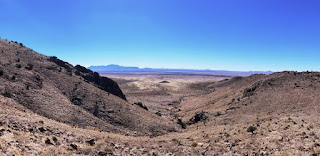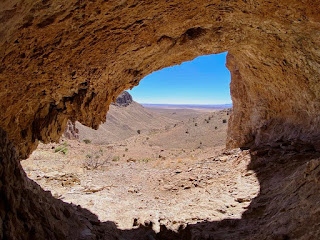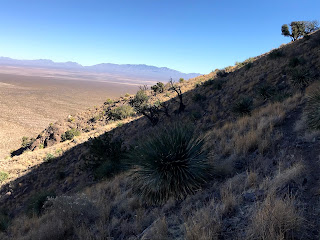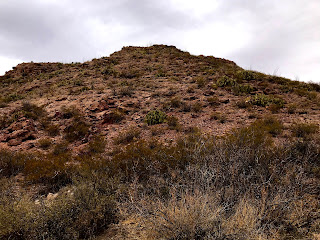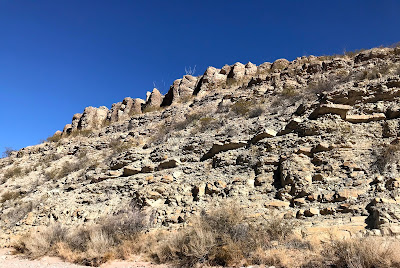Continuing my survey of canyons that drain to the Rio Grande from the Caballos, Redhouse Mountain, and the Rincon Hills, this past week we got to Mcleod Draw/ Arroyo ( on maps it starts out as "Draw" upstream and ends up as " Arroyo" further down). Despite the spelling it's pronounced like Mic- cloud or Mac-cloud except if you're a Scotsman you'll say that "c" more like we say the "ch" in Bach ( according to the online pronunciation guide).
Anyway, the road( EO 94,95) all the way to the corral downstream from Mcleod Tank is good county maintained gravel and dirt . On the con side we had to drive a bit on the un-maintained jeep trail to the northwest in order to park off of the section of private property. That road itself wasn't too bad, but there really wasn't anywhere to park, so we made a spot crunching over the brittle desert bushes( not the best idea as it will turn out, but more on that later).
Down we all went ( Andrea and I, plus dogs Seamus and Nessie) off the little hill we were parked on to immediately start negotiating the benches that are deeply cut by tributary crevices to the main arroyo. Sometimes we would get "stranded" and then have search around for the best way down. The cow paths weren't always reliable in helping us either, but after about a half mile we were in Mcleod Draw proper.
It had been windy and cold on the little hill where we had parked but we soon found our selves shedding layers as we discovered that the sweatshirts and jackets were not going be necessary. I had on my little winter beanie and had unintentionally left my cap behind, which made for a nice sunburn on my nose by the end of the day. Oh well.
On our way down to the box section, we mixed it up between the benches ( which amazingly still had some grass on them) and the sandy stream channel itself. There were willows that had kept their leaves, and desert willows which hadn't, down there and when we finally got to the box, a few small hackberry trees as well in the shade against the cliffs.
The terrain of the box was more interesting, though not spectacular, with its tilted beds of limestone, sandstone and shale occasionally shot through with some volcanics. Boulders blocked up the channel in places, which was now given over to stretches of bumpy gray bedrock.


It had been quite warm walking in the open terrain, especially for our shaggy black dogs ( grooming appointments are at premium during the pandemic) with the only shade pressed up against the vertical banks of dirt on each side of the draw. At the first bend in the box we took a leisurely lunch in the shadow of the cliffs where it was cooler, so much so, that my wife sat on the sunny side of the edge of the shade to stay warm.
About half-way through I noticed a hole in the cliffs with a blackened ceiling, so I went to investigate. The hole was pretty small it turned out, and had no easy way up to it. I surmised that the blackening of the yellow rock was probably from birds or bats and not from fires, but then, beneath a nearby overhang was a panel of petroglyphs. Hard to see and undoubtedly very old, they were still an unmistakable highlight of the trip.


Further on the canyon opened up. We went under fence across the arroyo but later found out that there was a gate up on bank. I went and explored near the old windmill( just back over the Doña Ana County line) while my wife and the dogs took another shade break. I found a fairly clear section of the old road that threads through this canyon ( I had seen a few lengths of it earlier), partly on the banks partly in the stream bed itself. It sees zero use these days, although we used parts of it to hike on the way back. There does seem to be some ATV use coming from the lower and upper ends of the canyon but none of it seemed to penetrate the middle section in the box.

I like long days of hiking like this. Even though the terrain close at hand wasn't that exciting, we did have nice views of the rugged north side of Redhouse Mountain. The return had many breaks from the warm winter sun for Scotties to rest, snack and drink.

Backing out of our non parking spot we immediately got a flat from a stick stuck in the side of the tire, the third this winter, and the fourth this year, after going at least 10 years without getting even one. It was changed in good time and we were soon enjoying the shadows among the hills at the close of day.
Labels: hiking, petroglyphs, rockhounding






